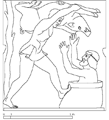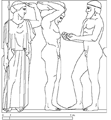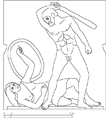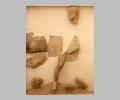
Amazon Metope: Overall view of metope
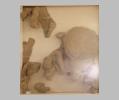
Geryon Metope: Overall view of the metope
| Collection: | Olympia Archaeological Museum |
| Title: | Olympia Metopes Overview |
| Context: | From Olympia |
| Findspot: | Excavated at Olympia |
| Summary: | Labors of Herakles |
| Material: | Marble |
| Sculpture Type: | Architectural |
| Category: | Statuary group |
| Placement: | Over the East and West Porches |
| Style: | Early Classical |
| Technique: | High relief |
| Original or Copy: | Original |
| Date: | ca. 470 BC - ca. 457 BC |
| Dimensions: | H 1.60 m (approximately square) |
| Scale: | Under life-size |
| Region: | Elis |
| Period: | Early Classical |
Subject Description:
We know from Pausanias (
The choice of Herakles for the sculptural decoration of a temple dedicated to Zeus, especially at Olympia, is understandable. He is not only a son of Zeus and great- grandson of Pelops but the preeminent athlete and founder of the Olympic Games. The Labors were sometimes referred to as the Athloi by the ancient Greeks and, as contests, required many of the same skills as those needed by contestants in the Games. The metopes may also be read in this wider sense, with references which go beyond a simple telling of Herakles' exploits.
The erection of the Temple of Zeus with its sculptural adornment represents the first major building following the Persian invasion of Greece. It is the first significant monument of the Early Classical period and the sculpture in particular illustrates the extraordinary change which has taken place since the Archaic Period. The metopes reflect this new attitude in virtually every respect. From the choice of the moment at which each Labor is depicted — usually late in the struggle or after its completion, rather than at its height — to the choice of composition — a distillation to the minimal number of characters presented in the the most simple geometric form — the overall impression is strikingly different from the archaic representations of these episodes. The details differ in an equally substantial way. The faces are somber, the drapery heavy with simple lines; the interest, whether in human form or emotion, is focussed on the underlying or internal rather than the
Condition: Fragmentary
Condition Description:
The degree of preservation varies greatly. Most fragments are in Olympia, where the entire series has been restored. A number of fragments are also in the Louvre.
Associated Building: Olympia, Temple of Zeus
Sources Used:
